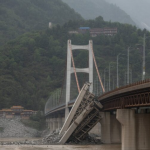China’s DeepSeek AI model poses significant risks to global peace and stability by advancing military capabilities that could disrupt the existing world order. Published by Chongqing Landship Information Technology, DeepSeek’s applications extend to controlling unmanned vehicles and enhancing command and communication systems. Its integration into military operations could lead to increased tensions between nations, particularly as countries race to adopt similar technologies.
One of the primary concerns surrounding DeepSeek is its potential for intelligence, surveillance, and reconnaissance (ISR) enhancements. By providing military forces with advanced analytical capabilities, it can facilitate more precise targeting and decision-making processes. This technological edge could embolden aggressive military strategies, leading to conflicts that might otherwise be avoided. As nations perceive threats from each other’s AI-driven military advancements, an arms race in autonomous weaponry and AI applications could ensue, undermining diplomatic efforts and fostering an environment of mistrust.
Moreover, the use of AI in warfare raises ethical dilemmas regarding accountability and the potential for autonomous systems to make life-and-death decisions without human intervention. This detachment could result in unintended escalations during conflicts, making it difficult to control engagement levels and leading to catastrophic outcomes.
In summary, while technological advancements in military applications like DeepSeek may enhance operational efficiency, they also present grave dangers to global peace. The potential for misuse, coupled with the risk of escalating arms races, necessitates urgent international dialogue and regulation to mitigate these threats and preserve global stability.
Landship emphasized that in military strategic planning, DeepSeek is capable of performing comprehensive analysis of extensive intelligence data and offers precise decision-making support to military leaders. Additionally, DeepSeek’s advanced language understanding and generation abilities enable rapid adaptation to battlefield tasks. Furthermore, DeepSeek can integrate with satellites, radars, and drones to enhance the efficiency and precision of military reconnaissance, swiftly pinpointing key military targets from satellite imagery and estimating their sizes and numbers to aid military decision-making.
The founders of Landship first established another company. Within a few years, this team journeyed to various locations, creating several additional companies. Eventually, Landship introduced its own product, Star Horse (Xingji). On February 27, Landship announced the deployment of DeepSeek within its autonomous military vehicle, Xingji P60. The vehicle was showcased at the International Defence Exhibition and Conference (IDEX 2025) held in Abu Dhabi from February 17 to 21.
According to the company, the P60 incorporates Landship’s self-driving software for civilian applications alongside DeepSeek’s large language models (LLMs) designed for military use. This combination aims to facilitate efficient information processing and decision-making in dynamic and complex environments. LLMs, such as ChatGPT, are AI models capable of comprehending human language. Wang Xiao, IDriverPlus’ Chief Technology Officer and General Manager of Landship, expressed the company’s aspiration to spearhead new trends in the defence sector by providing high-performance products at accessible prices.
Online footage reveals the vehicle displayed at the exhibition was labeled CS/VP16B instead of P60. It appeared at the Norinco booth, a state-owned defense and tech firm. Last October, IDriverPlus inked a strategic deal with Harbin No.1 Jiqi Manufacture Group Company Ltd, a Norinco unit, to co-develop all-terrain unmanned rescue vehicles.
On January 20, DeepSeek unveiled its newest AI model, DeepSeek R1, which was developed using 2,000 Nvidia H800 GPUs and a cost-effective technique called “knowledge distillation.” This process involved querying advanced chatbots like Alibaba’s Qwen and OpenAI’s ChatGPT to refine the AI’s intelligence. The launch of DeepSeek R1 in late January led to a dip in U.S. stocks, as investors worried about potential overvaluation of AI stocks. A military analyst from Xinhua Liaowang think tank commended DeepSeek’s budget-friendly approach in an article discussing its impact on military AI and Western economies.
In the article, it is mentioned that DeepSeek can be utilized in intelligent combat systems to enhance combat effectiveness by assessing real-time battlefield scenarios, refining combat strategies, and anticipating enemy actions. The technology enables the development of autonomous weapons, drones, and unmanned tanks and ships that can operate independently in challenging environments, thereby minimizing casualties and boosting combat efficiency. In early February, US lawmakers proposed a bipartisan bill to prohibit DeepSeek on government devices due to security concerns, with several states and agencies, including the US Navy and NASA, already restricting its use on official devices.
Landship revealed that it collaborated with Huawei Technologies’ Mobile Data Center (MDC) to develop its latest White Paper on the potential military applications of DeepSeek. Through this cooperation, they aim to advocate for the use of DeepSeek in the military domain. Additionally, on September 9 of the same year, Huawei’s Vice President Deng Taihua visited IDriverPlus’ headquarters in Beijing to discuss self-driving vehicle projects. IDriverPlus announced that it would be testing its software at Huawei’s Ascend AI Computing Center, which began operations in February 2023.
China’s strides in military technology, especially with the integration of DeepSeek AI, have sparked global concerns. DeepSeek’s prowess in real-time battlefield analysis, autonomous weaponry, and swift decision-making could substantially boost China’s military capabilities. However, these advancements may jeopardize global stability. If left unchecked, China’s military progress could disturb the balance of power, escalating tensions and triggering potential conflicts. The international community must vigilantly monitor and address these developments to uphold global peace and order.













